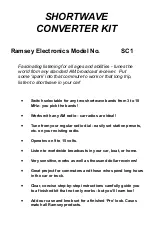
8. MAINTENANCE
DANGER! Unplug the inverter from the mains power supply before connecting or disconnecting cables or performing maintenance or service. Direct
contact with the inverter circuit is dangerous.
8.1
To avoid a build up of dust inside the machine which may block or restrict the ventilation system, periodically remove the covers and remove the dust with a
low pressure air jet or vacuum cleaner. Replace covers immediately. Under no circumstances should the machine be operated with the covers removed.
8.2
TORCH. Avoid resting the the torch and its associated cable on any hot surfaces. If the insulation is damaged in any way the torch must not be used.
8.3
Periodically check the condition of the gas tubing and the connections.
8.4
In the event of any problems of unsatisfactory weld performance please first go through the troubleshooting procedure shown in section 9. If this does not
solve the problem the Inverter must be taken to a qualified and authorised service agent for repair. Contact your local Sealey dealer for service.
7.1
The TIG161HFACDC will also perform ordinary MMA welding (without gas) using coated electrodes.(You will need optional ARC Accessory Kit INVMMA2)
7.2
Please note that the way the welding cables are connected to the inverter for ordinary MMA welding may be different to the way the cables are
connected for standard TIG welding. Whilst most stick electrodes are connected to the positive terminal certain types need to be connected to
the negative terminal. It is therefore essential that the user refers to the electrode manufacturers instructions to ensure that the correct polarity
is selected.
(Refer to section 3.2 regarding cable connection)
7.3
The mechanical characteristics of the weld will be determined not only by the current used but also by other factors such as the diameter and quality of the
electrode itself as well as the arc length, the speed of welding and the orientation of the electrode to the work surface. Unused electrodes should also be
protected from moisture as a damp electrode will affect the quality of the weld.
7.4
The table to the right gives a general guide to the minimum and maximum welding
currents to be used with the different diameter electrodes.
7.5
Depending on the diameter of the electrode the current used will have to be varied
depending on the orientation of the workpiece itself. Higher current values will be used for
flat welding whereas the current will have to be reduced for vertical or overhead welding.
7.6
ARC FORCE. When using the optional remote control with two potentiometers (See INV/
TIG/7 in section 3.6 on remote controls) an additional parameter of ‘arc force’ becomes
available. Arc force relates to the dynamic behaviour of the machine. Higher values of arc
force result in higher penetration and enable welding in any position using basic electrodes. By contrast, lower values of arc force result in a softer arc
without sparks using rutile electrodes. The welding machine is also equipped with HOT START and ANTI STICK devices to guarantee easy starts and to
prevent the electrode from sticking to the workpiece.
WARNING: Use welding head shield to protect eyes and avoid exposing skin to ultraviolet rays given off by electric arc. Wear safety welding
gauntlets.
If difficult welds are to be performed and the welding parameters are unknown, it is advisable to carry out several trial runs on test pieces in order to
determine the right welding current.
7.7
SWITCH ON
the welder only when you are satisfied that the welder is correctly connected and the work to be done is fully prepared.
Setting the controls.
7.8
Select the arc welding mode using the upper miniature toggle switch on the front panel.
7.9
Select the welding current parameter and set it to the required value by rotating the BUTTON AND ENCODER until the display shows the correct value.
7.10
Striking the arc.
Strike the electrode tip on the workpiece as if you were striking a match. (Do not hit the electrode on the work piece as this
could damage the electrode and make strike up difficult).
7.11
Welding.
As soon as the arc is ignited try to maintain a distance from the workpiece equal to the diameter of the electrode in use and maintain this distance
throughout the duration of the weld. Remember that the angle of the electrode as it advances should be 20 to 30° from a vertical line over the workpiece.
(See guide to weld bead characteristics in Section 10, Troubleshooting).
7.12
At the end of the weld bead, move the electrode backwards in order to fill the weld crater and then quickly lift the electrode from the weld pool in order to
extinguish the arc.
7.13
SWITCH OFF
the welder after use.
7. MMA WELDING PROCEDURE
Electrode diameter
Welding current
(mm)
Min.
-
Max.
1.6
25
-
50
2
40
-
80
2.5
60
-
110
3.2
80
-
140
4
120
-
200
Original Language Version
TIG161HFACDC Issue: 1 - 03/11/11
fig 11



























